Chapter 2.
IMPERATOR ANDRONICUS KOMNIN OF THE XII CENTURY - IT IS JESUS CHRIST DURING HIS PRESENCE IN TSAR-GRAD OF THE XII CENTURY.
50. WHO IS AUGUSTUS?
If the first year of Augustus coincides with the year 1211 A.D., then most likely in the Scaligerian history must be known an emperor who began his reign exactly in 1211. In fact there is such an emperor. We refer to Theodore I Laskaris, the founder of the Nicaean Empire and the founding father of the new dynasty. At first in Nicaea and then in Czar-Grad. Here we must explain. Usually the chronological tables give the beginning of Laskaris’ reign as 1205, and not 1211. But apparently Theodore had a brother and co-ruler Constantine Laskaris, who died in 1211 or 1212. Thus, only since 1211 or 1212 Theodore Laskaris becomes the sole sovereign ruler. Such a situation resembles the story of Augustus, who also began his reign as a co-ruler and only several years later became a sovereign ruler and emperor.
The information about Constantine, the brother of Theodore, is little known. Here it is: ‘The fact of Constantine Laskaris’ nomination to the throne in the perishing empire is rather problematic … According to some researchers … the enthroning (of Constantine – Author) nevertheless did take place and Constantine … acted there as a lawful emperor. However … having not found a common ground with his brother, Constantine XI lost his authority very fast … In 1211 or 1212 Constantine Laskaris died during the defence of the fortress Lentiana [44], p.277.
Theodore Laskaris became the founder of the dynasty which subsequently conquered Czar-Grad and established their authority there. It was the dynasty of Theodore Laskaris that the Russian princes and then the Russian czars-khans had close ties with. In this regard, the claims of the Russian nobility of originating from Augustus become understandable and just. The Hordian nobility originated from Theodore Laskaris. It was he who restored the Empire after defeating the Angelos dynasty who had persecuted Andronicus-Christ. We will present the details of the parallelisms between the biography of Theodore (i.e. God’s gift) Laskaris and ‘classical’ Augustus in the further publications.
51. JULIUS CAESAR = THE SUN CZAR IS A PARTIAL DUPLICATE OF ANDRONICUS-CHRIST.
In the Scaligerian history before Augustus was the famous Julius Caesar, i.e. the Sun Czar, if his name is translated in Russian (Julius – Helios = Sun). But as we begin to understand not long before Augustus there was reigning Andronicus-Christ. We have noted earlier one of the points overlapping Julius Caesar over Christ. We shall say at once that we refer only to a partial overlapping. We do not claim at all that the entire ‘biography’ of Julius Caesar consists of the Gospel events. It is not the case. Caesar’s biography is a rather complex layered chronicle which emerged quite late as a result of several different layers of the actual history mixing together. One of them it seems to be the biography of Andronicus-Christ from the XII century. The detailed discussion of these parallelisms exceeds the parameters of this book and we will outline it in our further publications. Here we shall note just the following interesting fact.
We all know a medial term ‘caesarean section’ or ‘caesarean’. In other words, when labour does not occur naturally, but by means of an incision in the abdomen’ [152]. Why is this incision called ‘Caesarean’? Because, according to some sources, that was exactly the way Julius Caesar was delivered at birth. For example in the aforementioned Palaea we read: “The original Roman kingdom of Iulii Kesar. In the third year of Cleopatra’s reign Iulii Kesar named VYPOROTOK (meaning ‘ripped’ or ‘torn’ - translator’s note) started his rule in Rome.” [104], page 254.
The nickname ‘vyporotok’ could perhaps mean that he was ‘ripped’ or ‘torn out’ of his mother’s womb. In other words he was removed by means of a medical procedure through an incision or section. This is the origin of the expression ‘caesarean section ’.
But on the other hand, similar information has survived about Christ too. Though little known today, but clearly expressed in the canonical church service. For example in the old Church Slavonic triadic canon of the second mode, recited on Sundays midnight vespers. Irmos of the ninth song of this canon sounds like this: (in English translation) : “Him, who before the Sun – God’s lantern – shined, and in flesh came FROM VIRGIN’S SIDE, infinitely incarnated, blessed and pure, we praise You, Mother of God” [193], p.66; [194], p.134.
The words: “He came in flesh from virgin’s side” are hard to interpret in any other way but as the birth via caesarean section by a Virgin. I.e. the Birth of Christ by Virgin Mary Theotokos.
We do not know any other case in history where they say of a great man or a king that he was born via caesarean section. Even if it exists it is ultimately occurs extremely rarely. The specified concurrence implies that there is a definite connection between the Sun Czar = Julius Caesar and Andronicus-Christ. The more in-depth analysis supports this. But here we shall leave it at that.
52. CAESAREAN SECTION.
Jesus’ birth by the caesarean section left its imprint not only in the liturgical texts of the Orthodox Church. This event was much talked about in the Middle Ages and spawned a multitude of views, theories and myths. The first thing that should be noted is the claim of the orthodox doctrine, that Theotokos (the Birthgiver) REMAINED A VIRGIN AFTER CHRIST’S BIRTH. These words are directly present in the Orthodox sacred worship, see above. Besides, this theme is in detail discussed in so called Apocrypha. To clarify, prior to the XVII century there were a lot of various pieces of writings about Christ in the Christian world. In the XVII century a new regime prohibited them and declared them to be ‘apocryphal’. At the same time many of them were considered canonical enough works even in the XVI century. They formed part of the authoritative canonical books, were copied in the monasteries along with the four canonical Gospels, creation of the holy fathers and Christian catechisms. One of the ways of disparaging the ‘inconvenient texts’ in the XVII century was the following: they started to name some of the ‘irritating sources’ - ‘Gospels’ (although they were not called that in the Church Slavonic tradition). For example they began to call the works attributed to Thomas the Apostle – ‘Gospel according to Thomas’. The idea is clear. The reformists were achieving the following goal: in the Christian world it was well known that in one of the Ecumenical Councils the four canonical Gospels, deemed appropriate for worship, were selected. The Gospels were the texts that ought to be read in the church at the certain time and on the certain occasion. And, clearly, they ought to be canonical, officially approved. In this sense all the other Gospels were renounced. But it didn’t mean that they were rejected entirely. They could remain as so called reference books. They could be kept at home and copied. But cunning reformists, by attaching the name ‘Gospel’ to any old text which displeased them, automatically labelled them as ‘incorrect, forbidden Gospels’.
Let us refer to so called ‘the Protevangelium of James’ (or The Gospel of James, also known as the Infancy Gospel of James - Tr. note). It is known, that ‘‘The Protevangelium of James’ was very popular in the Eastern churches. It was successfully copied and circulated. There survived its translations into Syriac, Ethiopic, Coptic and Armenian. In the XII century it appeared in Russia by the name of ‘Iakovleva povest’’. Some of its passages were adopted by the church and provided the ground for the Feasts of the Mother of God … Though the church did not include this apocrypha into the canonical books, it did not declare it a forbidden book either; ‘Iakovleva povest’’ was referred to as a scripture useful for reading’ [62], p.205-206.
This is what ‘Iakovleva povest’ tells us about the birth of Christ. We shall use the translation from [62]. ‘And he (Joseph – Author) found a cave there and brought her into it, and set his sons by her: and he went forth and sought for a midwife of the Hebrews in the country of Bethlehem… And the midwife went with him ... And the midwife said: My soul is magnified … for salvation is born unto Israel… the young child appeared: and it went and took the breast of its mother Mary. And the midwife cried aloud and said: Great unto me to-day is this day, in that I have seen this new sight. And the midwife went forth of the cave and met Salome. And she said to her: Salome, Salome, a MIRACULOUS SIGHT have I to tell thee. A VIRGIN HATH BROUGHT FORTH, WHICH HER NATURE ALLOWETH NOT. And Salome said: As the Lord my God liveth, IF I MAKE NOT TRIAL AND PROVE HER NATURE I WILL NOT BELIEVE THAT A VIRGIN HATH BROUGHT FORTH .. Arid Salome made trial and cried out and said: Woe unto mine iniquity and mine unbelief, because I have tempted the living God, and lo, my hand falleth away from me in fire… And lo, an angel of the Lord appeared, saying unto her: Salome, Salome, the Lord hath hearkened to thee: bring thine hand near unto the young child and take him up, and there shall be unto thee salvation and joy. And Salome came near and took him up… And behold immediately Salome was healed’ [62], p.217.
We shall quote another text referring to the same occasion, this is so called ‘The Gospel of Pseudo-Matthew’. It is, as it is thought, of the Western origin and its actual name is ‘The Book About the Origin of the Blessed Mary and the Childhood of the Savior’ [62], p.229. It says as follows: ‘Joseph had gone away to seek midwives. And when he had found them, he returned to the cave, and found with Mary the infant which she had brought forth. And Joseph said to the blessed Mary: I have brought thee two midwives--Zelomi and Salome… And when Zelomi had come in, she said to Mary: Allow me to touch thee. And when she had permitted her to make an examination, the midwife cried out with a loud voice, and said: Lord, Lord Almighty, mercy on us! It has never been heard or thought of, that any one should have her breasts full of milk, and that the birth of a son should show HIS MOTHER TO BE A VIRGIN. But there has been no spilling of blood in his birth, NO PAIN IN BRINGING HIM FORTH. A virgin has conceived, A VIRGIN HAS BROUGHT HIM FORTH, AND A VIRGIN SHE REMAINS (Virgo concepit, virgo peperit et virgo permansit)" [62], p.243.
Such an insistent claim in the sources that Theotokos (Birthgiver) REMAINED A VIRGIN AFTER GIVING BIRTH corresponds perfectly with Christ’s birth via caesarean section. Possibly this also explains that giving birth was pain free, which was also highlighted.
Now let us present the vaguer, but still compelling enough memories of the caesarean section during Christ’s birth. They have already become overgrown with fantastical details, but nevertheless the essence shines through. Let us address the chapter ‘Jesus in the rabbinic literature’ in the book [62]. As it happens, Christ is also mentioned in the Talmud. Although the information is rather blurry << The Talmud tells us about Jesus Christ rather indistinctly… The image of Jesus presented by the Talmud is a combination of various Judaic legends, rabbis’ commentaries and simply rumours… It is considered that Jesus appears in the Talmud under different names. The name of “JESUS, SON OF PANTERA (PANTIRA)” … is mentioned several times… the origin of the name “son of Pantera” presents us with a conundrum>> [62], p.301-302.
In regards to PANTERA scholars write: <<The etymology of the non-Jewish name Pantera has for many years presented a challenge to researchers… A theory was put forward in the middle of the last century, that the name Pantera appeared as a result of a linguistic mistake in the form of an incorrect reproduction of a Greek word ‘parthenos’ (Παρθενος) – ‘virgin’>> [62], p.305. However not everyone agreed with such an opinion.
In our opinion the Greek word PARTHENOS, i.e. VIRGIN (and this is exactly how the word VIRGIN sounds in the Greek Gospels) [62], p.305, has appeared in the Christian tradition as a recollection of the caesarean section of Christ’s birth. The word PARTHENOS originated from a Slavonic word POROT’, meaning ‘to rip open’, ‘to cut the body’ when performing the caesarean section. Furthermore, perhaps it contains a meaning of not only TO CUT OPEN, but also TO SEW UP, as PARTHENOS reminds us of a word PORTNOI (meaning A TAILOR), i.e. a person, who cuts and sews up. Naturally, after performing a caesarean section a doctor has to sew the wound up.
And Talmudic PANTERA, most likely, originates (as does PARTHENOS) from the same Slavonic word POROT’(TO CUT OPEN), PORTNOI (A TAILOR). That is why the authors of the XIX century, who associated this word with PARTHENOS, were correct.
But then immediately comes to mind a well-known myth about the birth of the ‘most ancient’ goddess Athena ‘via a cut in Zeus’ head’ see fig.2.99 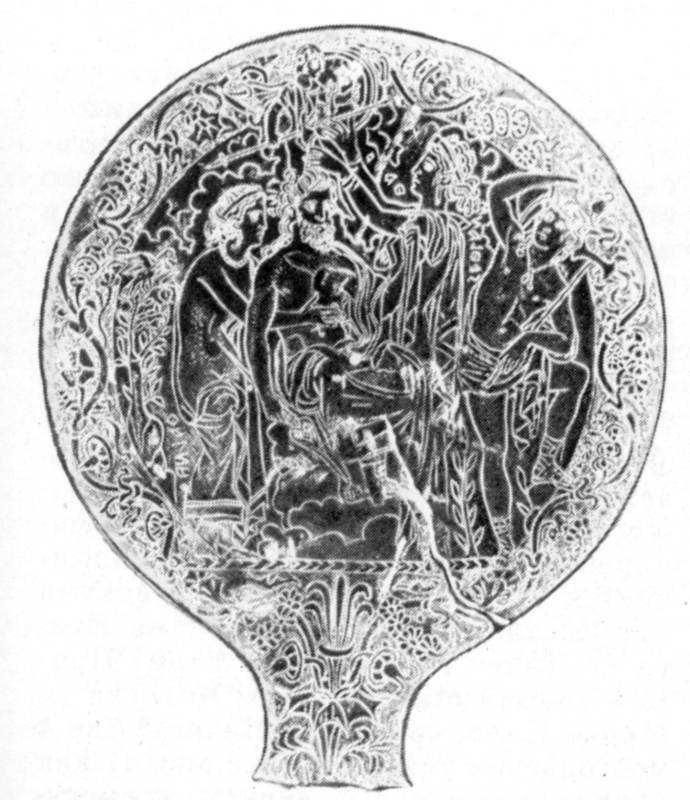 and fig.2.100
and fig.2.100  (the negative). Since long ago scientists became aware of the similarity between the ‘ancient’ Greek Athena Parthenos and medieval Christian Theotokos of Athens. This was discussed in great depth, for example, by the famous historian of the XIX century F.Gregorovius in [39]. See details in CHRON1, ch.7:5 and CHRON2, ch.3:15. Moreover, in the medieval times the famous Athenian Parthenon (i.e. the temple of Athena Parthenos) was nothing other than a Temple of the Virgin Mary Theotokos [39], CHRON2, ch.3:15. Besides, Athena was also called PALLAS. The word Pallas means A VIRGIN [40], p.60. The ‘ancient’ Greek myths constantly emphasise that Athena was A VIRGIN [40], p. 112, 114.
(the negative). Since long ago scientists became aware of the similarity between the ‘ancient’ Greek Athena Parthenos and medieval Christian Theotokos of Athens. This was discussed in great depth, for example, by the famous historian of the XIX century F.Gregorovius in [39]. See details in CHRON1, ch.7:5 and CHRON2, ch.3:15. Moreover, in the medieval times the famous Athenian Parthenon (i.e. the temple of Athena Parthenos) was nothing other than a Temple of the Virgin Mary Theotokos [39], CHRON2, ch.3:15. Besides, Athena was also called PALLAS. The word Pallas means A VIRGIN [40], p.60. The ‘ancient’ Greek myths constantly emphasise that Athena was A VIRGIN [40], p. 112, 114.
Let us now look at the ‘most ancient’ of myths about the birth of Athena Parthenos. Now the Christian origin of this myth is thus elucidated. This is what we are told: ‘Zeus… swallowed whole his pregnant wife and afterwards with the help of Hephaestus (or Prometheus), who cleaved Zeus's head with the axe, he sired Athena who leaped from Zeus's head, fully armed, with a warlike cry’ [95], v.1, p.126. See fig.2.101  . Through these fantastical details can be clearly seen peeping through the birth of Jesus by caesarean section from the Virgin Mary. Here Virgin = Athena ‘changes places’ with Jesus = Zeus: but the Virgin doesn’t give birth to Jesus, but Jesus (Zeus) gives birth to the Virgin. The incision in the ‘Greek’ myth wholly remains, but ‘moved’ to the god’s head. Incidentally, another character is also mentioned here – a doctor, who performed the incision. He was called Prometheus or Hephaestus. See also fig.2.102
. Through these fantastical details can be clearly seen peeping through the birth of Jesus by caesarean section from the Virgin Mary. Here Virgin = Athena ‘changes places’ with Jesus = Zeus: but the Virgin doesn’t give birth to Jesus, but Jesus (Zeus) gives birth to the Virgin. The incision in the ‘Greek’ myth wholly remains, but ‘moved’ to the god’s head. Incidentally, another character is also mentioned here – a doctor, who performed the incision. He was called Prometheus or Hephaestus. See also fig.2.102 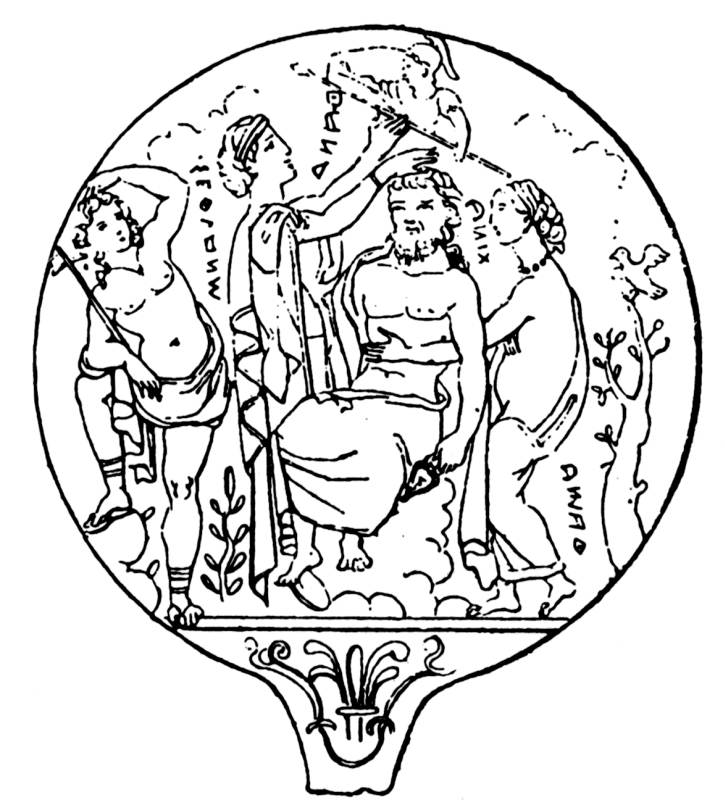 , fig.2.103
, fig.2.103 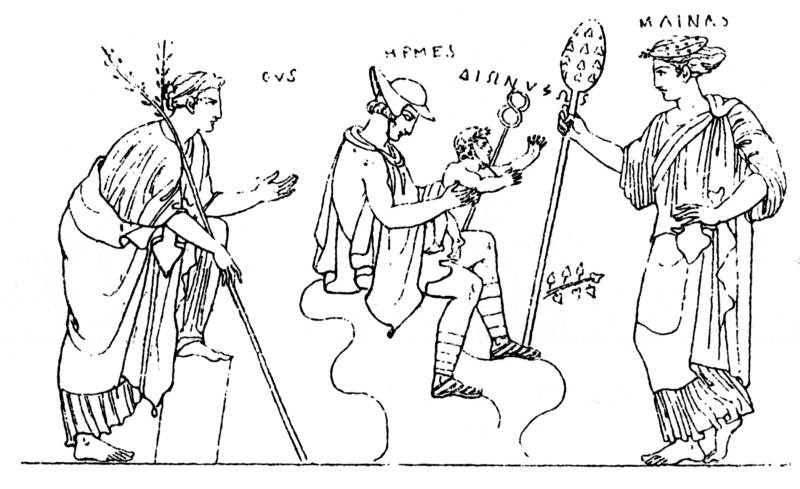 , fig.2.104
, fig.2.104 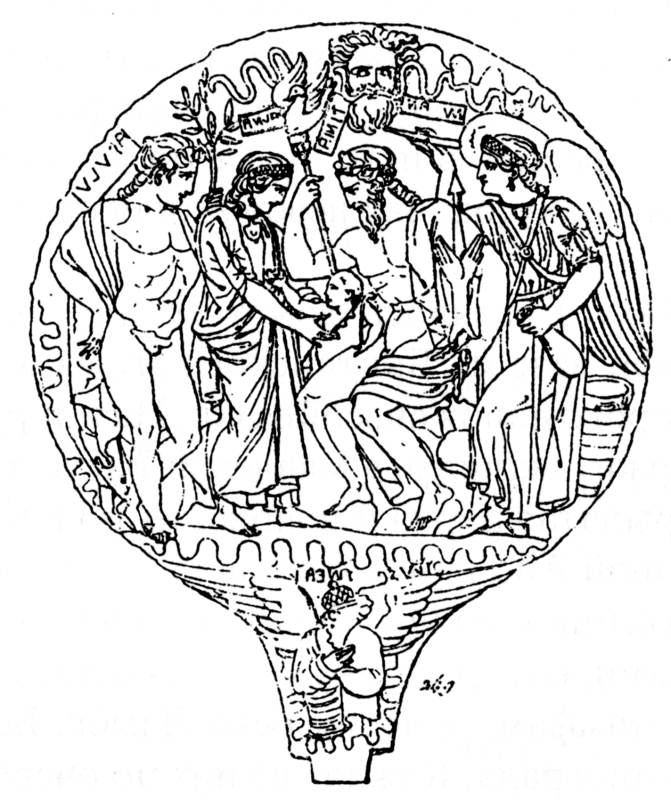 , fig.2.105
, fig.2.105 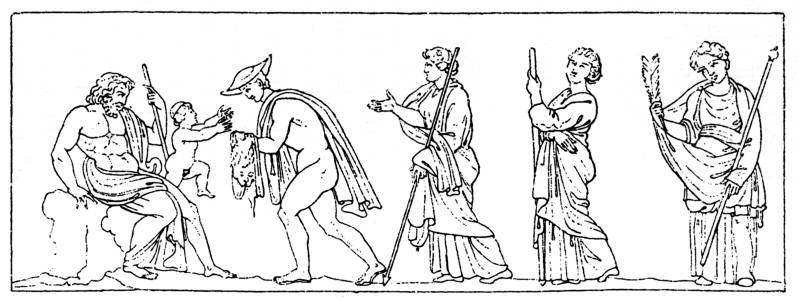 , fig.2.106
, fig.2.106  .
.
We shall suggest an idea about a possible origin of this most ‘ancient’ of the Greek myths. It could have appeared while observing the Orthodox icon ‘The Assumption of the Blessed Virgin Mary’, see fig.2.107 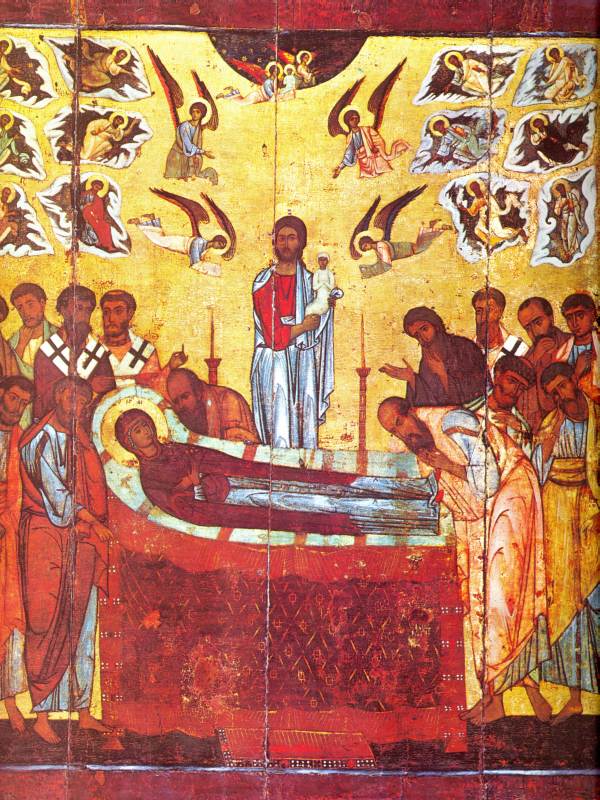 . ‘The Assumption’ presents The Virgin Mary is on her deathbed, Christ stands above her and holds in his hands, at his shoulder level, a tiny figure of the Virgin Mary swaddled in a white piece of cloth, see fig.2.108
. ‘The Assumption’ presents The Virgin Mary is on her deathbed, Christ stands above her and holds in his hands, at his shoulder level, a tiny figure of the Virgin Mary swaddled in a white piece of cloth, see fig.2.108  . Surely, a person, who knows icon-painting well, understands that this small figure symbolises here The Virgin Mary’s soul. But a lay person and moreover a visitor from afar, who knows little about the tradition of icon-painting, could easily interpret such an image as the birth of a little maiden from an adult God. Next the imagination would take over. As a girl was painted close to Christ’s head it ‘therefore meant that she was born from the head’. And in order ‘to give birth to it’ one should first ‘swallow it’. And so on. Having returned home, to ‘ancient’ Greece of the XIV-XVI cc. from a distant capital of the Great = ‘Mongol’ Empire, the awed traveller would share with his fellow citizens ‘deep knowledge’ about the life of the Olympian gods on faraway Olympus. That is how an ‘ancient’ myth could have been born. As we note in the following chapter 3, it was Rus’ that was considered to be “Virgin Mary’s Home’ as she had spent the significant part of her life in Rus’ and most likely died there. That is why the images of ‘Assumption of the Blessed Virgin Mary’ most likely originated in Rus’. And later, as Christianity was progressing in Western Europe, the images, inspired by these Orthodox icons, appeared there as well. See for example ‘The Death of the Virgin’ (‘The Entombment of Mary’) by Giotto in fig.2.109
. Surely, a person, who knows icon-painting well, understands that this small figure symbolises here The Virgin Mary’s soul. But a lay person and moreover a visitor from afar, who knows little about the tradition of icon-painting, could easily interpret such an image as the birth of a little maiden from an adult God. Next the imagination would take over. As a girl was painted close to Christ’s head it ‘therefore meant that she was born from the head’. And in order ‘to give birth to it’ one should first ‘swallow it’. And so on. Having returned home, to ‘ancient’ Greece of the XIV-XVI cc. from a distant capital of the Great = ‘Mongol’ Empire, the awed traveller would share with his fellow citizens ‘deep knowledge’ about the life of the Olympian gods on faraway Olympus. That is how an ‘ancient’ myth could have been born. As we note in the following chapter 3, it was Rus’ that was considered to be “Virgin Mary’s Home’ as she had spent the significant part of her life in Rus’ and most likely died there. That is why the images of ‘Assumption of the Blessed Virgin Mary’ most likely originated in Rus’. And later, as Christianity was progressing in Western Europe, the images, inspired by these Orthodox icons, appeared there as well. See for example ‘The Death of the Virgin’ (‘The Entombment of Mary’) by Giotto in fig.2.109  .
.
This is how the very same story reflected in the Judaic version of the Gospel events in so called ‘Toledot Yeshu’. We quote the translation of the mediaeval Viennese manuscript written in Aramaic [62]: ‘He (Jesus – Author) entered the Temple where was the Foundation Stone on which were engraved the letters of God's Ineffable Name … and so Yeshu (Jesus - Author) wished to get hold of the secret… Lions of brass were bound to two iron pillars at the gate of the place of burnt offerings. Should anyone enter and learn the Name, when he left the lions would roar at him and immediately the valuable secret would be forgotten… What did Yeshu do? He pronounced the letters of the Name OVER HIS THIGH, CUT IT OPEN WITHOUT FEELING ANY PAIN AND PLACED INTO THE OPEN CUT ON HIS THIGH A PARCHMENT upon which he wrote the secret letters, and then drew the flesh over the parchment and before leaving he charmed the cut. As he left, the lions roared and he forgot the secret, but the parchment was still remaining in its place, but when he came to his house HE REOPENED HIS CUT IN HIS FLESH WITH A KNIFE AND LIFTED OUT THE WRITING. THEN HE REMEMBERED AND OBTAINED THE USE OF THE LETTERS. HE WAS THE ONLY ONE WHO DID THIS AND AFTER THAT HE WAS ABLE TO DO WHATEVER HE WISHED’ [62], p.360-361. The cut in the thigh ‘made by Christ’ left such a strong impression over the Jewish writers that they returned to it again and again. In the rabbinic literature there even appeared a special term ‘One who cuts his own flesh’ [62], p.315-316. He is discussed in many places and is clearly connected with the aforementioned story.
In this version of the Christian myth ‘a parchment with the secret letters’ appears from the cut in the thigh. The other Jewish texts speak of it even more openly: ‘Ieshu cut his thigh open without feeling any pain and placed the secret Name written on a piece of skin, then he went away, took out that piece of skin with the secret letters and began to create spells and perform miracles’ [62], p.379. Here ‘the secret Name’, born from his thigh, clearly resembles of the Christian name of Christ THE WORD: Christ – The Word was God. See for example the beginning of the Gospel of John.
Incidentally, the painlessness of the cut is being stressed. Certainly, the fantastical decoration here is different, but the essence is the same. In regards to the word PARCHMENT, it is most likely a result of the distortion of the word PARTHENOS or POROT’ (‘cut out’ in Russian).
But let us return to Zeus. It appears, that he gave birth not only to Athena from his head, but also to Dionysus=Bacchus from HIS THIGH. Thus the Judaic version of the caesarean section is also present in the ‘ancient’-Greek myths about Zeus clearly and openly. We quote: <<However the main myth goes like this. Having disguised himself as a mortal, Zeus had a secret love affair with Semele (‘Earth’), the daughter of the Boeotian king Cadmus … Hera… advised Semele, who was already six months pregnant, to demand of her mysterious lover to reveal his true form… He came to her wreathed in bolts of lightning and roars of thunder and incinerated her. However, Hermes managed to save her six months premature son. Hermes SEWED A BABY INTO ZEUS’ THIGH, AND AFTER THREE MONTHS, IN DUE TIME ZEUS GAVE BIRTH TO HIM. Hence Dionysus is called ‘twice-born’ or ‘a child of double doors’>> [40], p.69.
In this myth, as in the Judaic texts, Christ sort of gives birth to himself from his thigh. Here Zeus is Jesus, and Dio-nysus = Nicaean God is also Jesus. Identifying Dionysus-Bacchus (Adonis?), the dying and resurrected god of the ‘ancient’ Greeks, with Jesus, was not suggested by us. Many researchers spoke about it, for example Arthur Drews [186], in view of the strong correspondence between the cult of Dionysus and Christianity. Naturally the commentators explained such parallels by purportedly adopting the doctrines of Christianity from the more archaic pagan beliefs. But from the point of view of the new chronology the picture is reverse. Pagan cultures were variations of Christianity, common in the Middle Ages. Besides the mainstream of Christianity, there existed various sects and cults. They were later declared to be “the most ‘ancient pagan’ religions. And then, already in the XIX century, they were surprised to discover that they suspiciously resembled Christianity. A vast platform opened for the ‘scientific explanation’ of this phenomenon.
We should note that a nickname BORN TWICE corresponds with the two births of Christ in the Cristian teaching: the everlasting birth and birth from the Virgin Mary (the Birthgiver). In regards to the nickname A CHILD OF DOUBLE DOORS, IT CLEARLY HINTS AT THE CAESAREAN SECTION.
It seems that in front of us is the very same legend, which in one case refers to Zeus and Dionysus=Bacchus, and in the other – to Christ.
Given examples illustrate how widespread the myth of the birth of Jesus by caesarean section really is. You can see how passionately and how much this event was discussed if it generated such a multitude of versions, notably in places of wide ranging geographic and linguistic diversity.
53. SUPREME GOD ZEUS AS THE REFLECTION OF JESUS CHRIST IN THE FOLK MYTHS.
As their analysis shows the ‘ancient’ Greek myths about Zeus came largely from the stories about Jesus Christ. The name ZEUS itself clearly resembles JESUS or EZUS. In the words ZEUS and EZUS all the letters are the same, but in different order.
According to the ‘ancient’ Greeks’ beliefs ‘people associate the foundations of national identity, order and morals with … the actions of Zeus’ [95], v.1, p.465. It wonderfully corresponds with the biography of Andronicus-Christ which we have analysed earlier. In fig.2.110 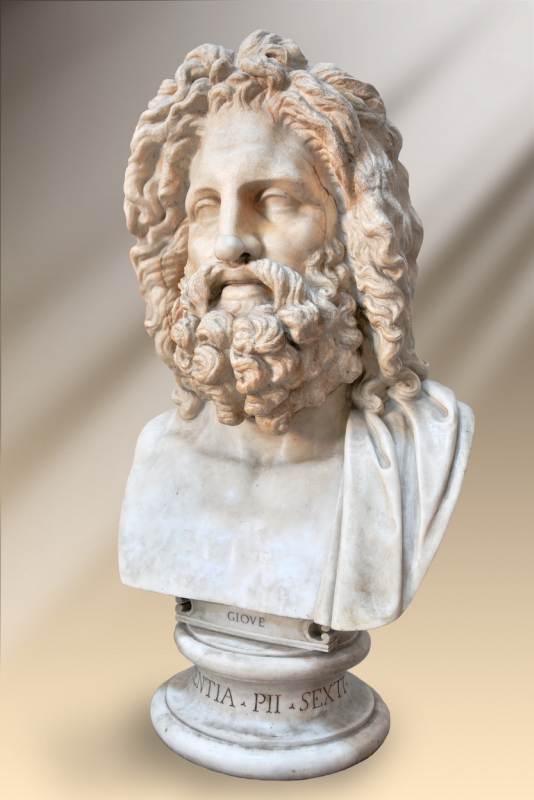 we present the ancient image of ‘The Zeus of Otricoli’. Like Andronicus-Christ Zeus also has very long hair and a forked beard. Another image of Zeus on a throne is also very interesting, see fig.2.111
we present the ancient image of ‘The Zeus of Otricoli’. Like Andronicus-Christ Zeus also has very long hair and a forked beard. Another image of Zeus on a throne is also very interesting, see fig.2.111  . It is placed on a silver coin of allegedly year 325 B.C. But on the coin it is written ‘Alexandroy’ and not ‘Zeus’. Thus ALEXANDER was one of Zeus’ names. But it was close to the name ANDRONICUS. Both of them in Greek mean simply ‘a man’. ALEXANDER = Alex + Ander. There is another interesting detail. There is a bird sitting on Zeus-Alexander’s hand, it looks like a hunting bird. It was possibly connected with the fact that Andronicus-Christ according to the chroniclers while staying in Russia was very keen on Russian hunting, see above and the following chapter 3.
. It is placed on a silver coin of allegedly year 325 B.C. But on the coin it is written ‘Alexandroy’ and not ‘Zeus’. Thus ALEXANDER was one of Zeus’ names. But it was close to the name ANDRONICUS. Both of them in Greek mean simply ‘a man’. ALEXANDER = Alex + Ander. There is another interesting detail. There is a bird sitting on Zeus-Alexander’s hand, it looks like a hunting bird. It was possibly connected with the fact that Andronicus-Christ according to the chroniclers while staying in Russia was very keen on Russian hunting, see above and the following chapter 3.
We should also note the following interesting fact. Zeus was also called by the name of DII OR DYI, see for example [95], v.1, p.463. The historians report: ‘Zeus was called by the name of DYI (Dyi Kritskii) in the Russian sources’ (The name of DYI was used to call Zeus) [122], p.335.
We tried to find all the geographical names on the map of Russia of the early XX century which include the words DYI or DII. We found such names, there were only two of them. They are – DIEVO gorodishche (or Dievy-Gorodischa) in the Yaroslav region on the left bank of Volga river, 18 versts below Yaroslavl (versta is an obsolete Russian unit of length equal to 1.0668 kilometres - Tr.note), and also a village of DIEVKA on Dnieper river 12 versts from Ekaterinoslavl, modern Dnepropetrovsk [154].
As we already know in Russia Andronicus-Christ stayed with ‘the Russian prince Yaroslav Osmosmysl Galitskiy’ [44], p.257-258. I.e. was in the Galitskiy (or Galich) district. In the old maps of Russia and Europe there were a lot of Galitskiy districts or Galitsias. There was a part of Spain called Galicia. There is a district in Trans-Dniester bearing this name. But there was also Volgian (Volzhskiy) Galitsiya or Galich land. It was situated around the city of Galich which today is in the Yaroslavl region. But in the old times the city of Galich had an independent significance and the region around it was called after it – Galitskaya oblast’. See for example the French map of 1755, the fragment of which we present in fig.2.112 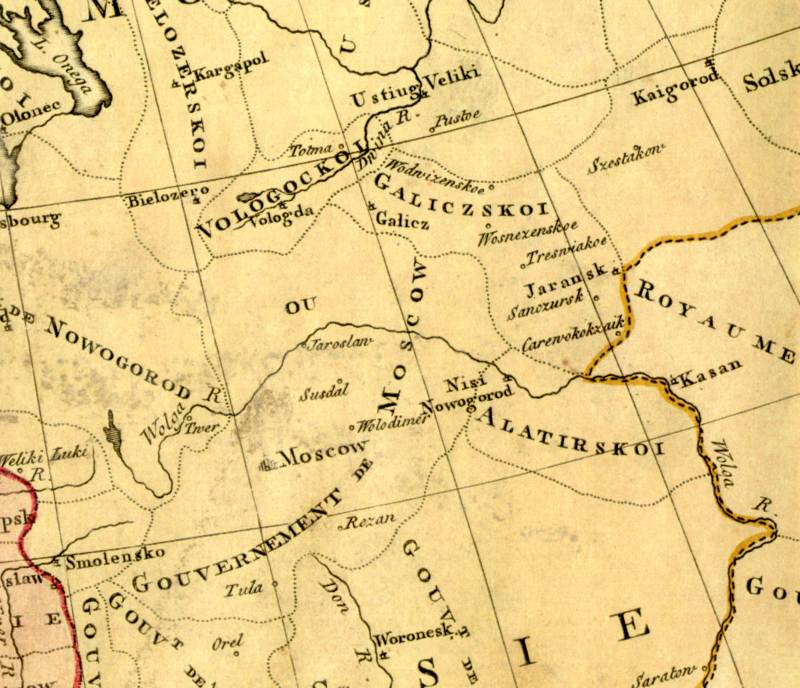 . It is interesting in the map of Moskovia from the ‘Universal Cosmographia’ by Sebastian Münster allegedly of 1544 neither Yaroslavl, nor Kostroma are marked, but the city of Galich (Haliz) is present, see fig.2.113
. It is interesting in the map of Moskovia from the ‘Universal Cosmographia’ by Sebastian Münster allegedly of 1544 neither Yaroslavl, nor Kostroma are marked, but the city of Galich (Haliz) is present, see fig.2.113  . In the Russian postal route map of 1813 there is marked a region surrounding Galich, stretching over Kostroma and reaching almost as far as Yaroslavl, see fig.2.114
. In the Russian postal route map of 1813 there is marked a region surrounding Galich, stretching over Kostroma and reaching almost as far as Yaroslavl, see fig.2.114  .
.
From the older documents of the XVII century we learn that the city of Shuya belonged to the ‘Galitskaya chet’(region)’ As the city of Galich is situated to the North-East consequently Galitskaya chet’, that is Galitskaya region engulfs Kostroma and also most likely Dievo Gorodishche. Let us note that Galitskaya chet’, i.e. Galitskaya region in the XVII century was called specifically GALITSKAYA, but not GALICHSKAYA. Therefore the region surrounding Kostroma on both sides of Volga river was really earlier known as GALITSIA, GALITSKAYA region. Thus, for example, it is said in the charter of 22nd December 1649 from Czar Alexey Mikhailovich to Semeon Ilyich Zmeev, the governor of Shuya: ‘From the czar and Grand Duke Aleksei Mikhailovich of Russia to Shuya to our governor Semeon Ilyich Zmeev. In the current year of 157, on the 22nd day of December, to Galitskaya chet’, to our diak (clerk) Semeon Safonov in the edict from Streletsky Prikaz (Streltsy Department, one of the main governmental bodies in Russia in 16th and 17th centuries – Tr. note)’. Сit.ex [27], p.376. We shall clarify that by year 157 the letter refers to year 7157 from Adam, i.e. year 1649. Here by the way we see that even in the XVII century, when writing the years according to the era from Adam, the thousands digits were omitted. Even in the official documents.
It follows from this letter that the czar’s ‘pamyat’’ (i.e. edict) to the governor of Shuya was passing through Galitskaya chet’. In this way the city of Shuya from the point of view of Moscow officials of that time belonged to Galitskaya chet’. According to Giles Fletcher, the English author of the work ‘On the state of Russia’, Galitskaya region surrounding Galich and Kostroma of Yaroslavl district was one of 16 ‘original regions belonging to Russia’ and included in the title of Moscow czar [136], p.16.
Dievo Gorodishche, i.e. Zevsovo (Zeus’) Gorodishche is situated on the border between Yaroslavl and Kostroma. The name of the deity DIY could possibly originate from the Slavic word DEIYU, i.e. I create, I construct.
The story of Dievo Gorodishche, as thought, dates back to deep antiquity [83]. Here was situated the centre of the apanage principality, the ancestral lands of the boyars Kolychevy. Thus in Russia not far from the ancient city of Galich we find a clear trace of Diy, aka Zeus, aka Jesus staying there. Aka, as we understand it now, of Andronicus-Christ. In this way we’ve come full circle. We know about Andronicus, that he stayed in Russia with Galitsky prince Yaroslav, see above. Incidentally Dievo Gorodishche is situated quite close to the city of Yaroslavl, approximately 18 kilometres from the centre, see fig.2.115 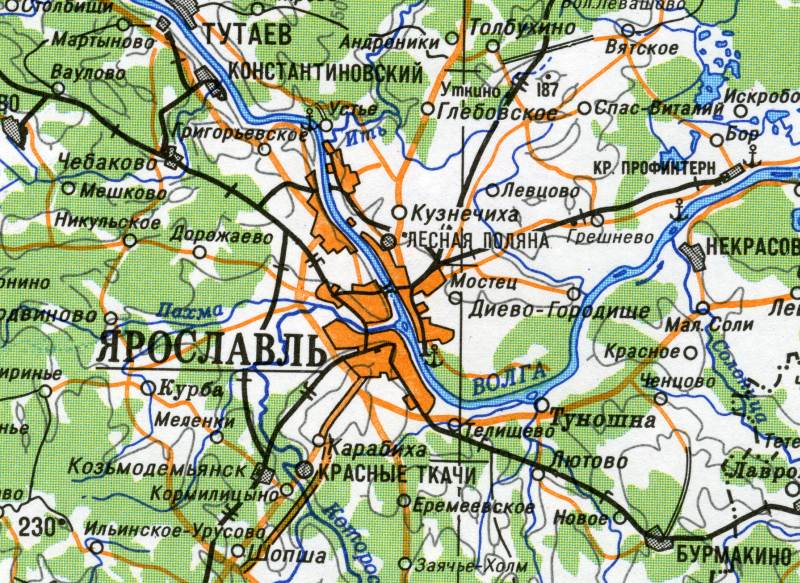 .
.
Dievo Gorodishche is not the only trace of the famous ancient guest visiting these parts of the world. Approximately 60 kilometres from it, on the Klyazma river, to the North of Rostov Velikiy, not far from Nero lake, there is situated an old Belogostitskiy monastery (the village of Belogostitsy) [157]. See fig.2.116 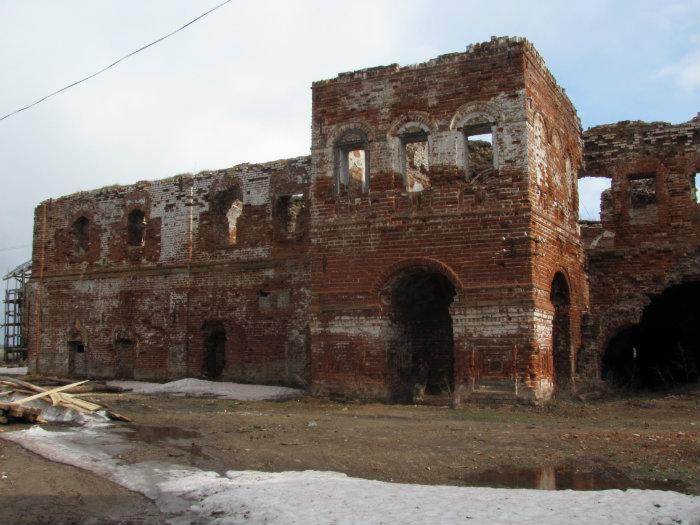 . The name of Belogostitsy itself ‘is connected with the visit of the ‘White Guest’ – prince Kiy, the founder of Kiev’ [96], v.1, p.62. This is one of the oldest monasteries in Vladimir and Suzdal land. The exact date of its origin is unknown. It has been established that it already existed in the XV-XVI cc., and was mentioned in Ivan the Terrible’s letters. According to the legend earlier in the place of the monastery there were situated two wooden churches: in the name of St.Georgiy, founded in year 997 by Prince Yaroslav Vladimirovich, and in the name of Annunciation of the Lord, erected in year 1213 under Prince Konstantin Vsevolodovich’ [96], v.1, p.62. Certainly, the given dates – years 997 and 1213 - could not be trusted. Most likely, as we begin to understand, the first churches here were erected after 1185, in memory of Andronicus-Christ who was visiting there. It is clear why the legend calls him Kiy, the founder of Kiev. We have already spoken a lot about the fact that Kiev of the XII-XIII cc. in the Russian chronicles is in reality Czar-Grad in Bosphorus, but not Kiev in Ukraine. When the Romanovs invented a theory about Kievan Rus’ and moved the beginning of the Russian chronicles to Dnieper, Ukrainian Kiev began to play (on paper) the role of the ancient czar-Grad in Bosphorus.
. The name of Belogostitsy itself ‘is connected with the visit of the ‘White Guest’ – prince Kiy, the founder of Kiev’ [96], v.1, p.62. This is one of the oldest monasteries in Vladimir and Suzdal land. The exact date of its origin is unknown. It has been established that it already existed in the XV-XVI cc., and was mentioned in Ivan the Terrible’s letters. According to the legend earlier in the place of the monastery there were situated two wooden churches: in the name of St.Georgiy, founded in year 997 by Prince Yaroslav Vladimirovich, and in the name of Annunciation of the Lord, erected in year 1213 under Prince Konstantin Vsevolodovich’ [96], v.1, p.62. Certainly, the given dates – years 997 and 1213 - could not be trusted. Most likely, as we begin to understand, the first churches here were erected after 1185, in memory of Andronicus-Christ who was visiting there. It is clear why the legend calls him Kiy, the founder of Kiev. We have already spoken a lot about the fact that Kiev of the XII-XIII cc. in the Russian chronicles is in reality Czar-Grad in Bosphorus, but not Kiev in Ukraine. When the Romanovs invented a theory about Kievan Rus’ and moved the beginning of the Russian chronicles to Dnieper, Ukrainian Kiev began to play (on paper) the role of the ancient czar-Grad in Bosphorus.
So, most likely, Andronicus-Christ, aka Apostle Andrey, stayed specifically in the Upper Volga in the vicinity of Yaroslavl. There is good reason for saying that Apostle Andrey reached Novgorod and was surprised by the Novgorodian baths (or steam rooms - Russian sauna – Tr. Note), see below chapter 4. We shall remind you, that according to our research the chronicles’ Velikiy Novgorod is the land of Vladimir and Suzdal Russia situated around Yaroslavl – ‘Yaroslavovo Dvorishche of Velikiy Novgorod’, see our book ‘The New Chronology of Russia’ (‘Novaya Chronologiya Rusi’ or CHRON4.
Possibly, this is the reason, among other things, which explains the significance of Vladimir and Suzdal Russia and Yaroslavl= Velikiy Novgorod which they acquired after the great = ‘Mongol’ conquest. It is here where the capital of the Great Empire of the XIV-XVI cc. was established. As it was here where Christ was.
As we have touched upon the correspondence between Zeus and Jesus Christ we shall briefly describe the parallelism between them. As we are dealing with the myths, we should recognise that in front of us there is rather vague material which had passed through many different hands. Nevertheless the vivid characteristics shine through, and it seems to us they are rather obvious.
- As it was said before, the name ZEUS is practically the same as the name JESUS or EZUS.
- THE FOREFATHER of the Olympian gods – Zeus’ relatives (his brothers and sisters) – was called EROS. According to some Greek myths he is a primordial god. ‘There are those who claim that Eros who was born from a germless egg was THE FIRST GOD as no one can be born without him’ [40], p.71. The FOREFATHER of the Komnenus dynasty, which Andronicus-Christ belonged to, is thought to be Manuel EROTIKOS Komnenos [44], p.223.
- The Nativity of Christ is dated as 25 December when the Sun was in the Constellation Sagittarius (in the Middle Ages). That is why it is not a coincidence that the Constellation of Sagittarius, i.e. Centaurus, represented Christ, see above. Its neighbouring constellation is Capricorn, according to the myths represented a goat Amalthea who suckled and infant Zeus with its milk [40], p.51. See fig.2.117
 and fig.2.118
and fig.2.118  .
. - Immediately after his birth Zeus was compelled to flee from his father Cronus who wants to swallow him, fearing that Zeus would take his place as a king [40], p.51. The reason for this fear was a certain prophesy [40], p.51. Earlier we have already discussed in detail the corresponding flight and wandering of Christ-Andronicus. There it also says about the prophecy that the newly born baby Jesus will become the king. This was the reason why Herod tried to find and kill him. Here is what is says about Zeus: ‘According to the prophecy of mother-earth and dying Uranus, Cronus was going to be overthrown by one of his sons, born to him by Rhea’ [40], p.51-52. Cronus devoured five of his children (Gospel Massacre of the Innocents?). He is characterised as a cunning and treacherous god [82], p.7.
- Then the war of Zeus against Cronus begins. The brothers and sisters of Zeus suggested that he should lead them in their fight against the titans, who chose a giant Atlas as their leader; by that time Cronus was passed his prime. The war lasted for ten years’ [40], p.52. Here, apparently in a poetic form is described the opposition of Andronicus-Christ and emperor Alexios, the successor of Manuel-Herod, see above. The war ended with the victory of Zeus. That is of Andronicus-Christ.
- ‘However there came the day when Zeus’ arrogance and capriciousness became so unbearable that Hera, Poseidon, Apollo and the other Olympians, with the exception of Hestia, suddenly surrounded him while he was asleep and ‘chained’ him with the ox-hide ropes with hundreds of knots so, that he could not even move. He was threatening them with the immediate death, however in response the gods, who cautiously hid his lightning bolt, only laughed insolently …they were already celebrating their victory and zealously discussed who would become Zeus’ successor’ [40], p.67. Further the myth is telling us that Zeus after all was freed with the help of the Nereid Thetis. But nevertheless the trace of the crucifixion, and a very bright one, is still present. ‘As Hera (Hera = Horus – the very same Christ – Author) was at the head of the plot, ZEUS HUNG HER WITH GOLDEN BRACELETS IN THE SKY AND BOUND HER FEET WITH ANVILS. Though the gods were deeply outraged by Zeus’s action, no one dared to help Hera, despite her pitiful wailing’ [40], p.67. Moreover, HERA WAS SUBJECTED TO FLAGELLATION [82], p.26.
- There is also a vivid enough trace of the Resurrection present in the myth about Zeus. ‘ The Cretans … say that every year Zeus is born in the same cave in the blazing fire and floods of blood and every year he dies and is buried’ [40], p.53. This resembles of the annual cycle of the Christian holidays, representing Nativity, death and Resurrection of Christ.
- Christ’s descent into hell. The myths about Zeus tell us, that ‘he secretly came to old Campe, who kept guard over Tartarus, slew her, took her keys and freed the cyclopes and the Hecatoncheires (hundred-handed ones), refreshing their strength with the food and drink of gods.’ [40], p.52. To remind you, according to the Christian teaching, Christ descended to hell, broke its gates and by force set free those imprisoned there.
‘Rhea was beside herself with rage from what was happening. She gave birth to her third son – Zeus, in the dead of night on the mountain of Lykaion … and hid him in the cave called Dictaeon Andron (Psychro Cave) in Lasithi plateau, having left him in care of a nymph named Adrasteia and her sister Ida (Io) … and a goat-nymph Amalthea … The golden cradle with baby Zeus hanging on the tree … was surrounded by the armored Kouretes – Rhea’s children. They prevented Cronus from hearing the baby Zeus’ cries by beating their swords on their shields, drowning out the sound… However Cronus found out the deception and began to persecute Zeus, who was compelled to turn into a serpent, and to turn his nurses into the bears. Zeus reached manhood … whilst living in a different cave… He visited his mother Rhea and asked her to make him Cronus’ cupbearer’ [40], p.51-52.
Here are visible the characteristic features of the Gospel stories. Christ’s birth in a cave. Two strange women taking care of a new born child. The animals in the same cave – a goat Amalthea. Infant-Christ lying in a manger among the livestock, - one of the most popular subjects of the Mediaeval paintings, see for example fig.2.119  and fig.2.120
and fig.2.120 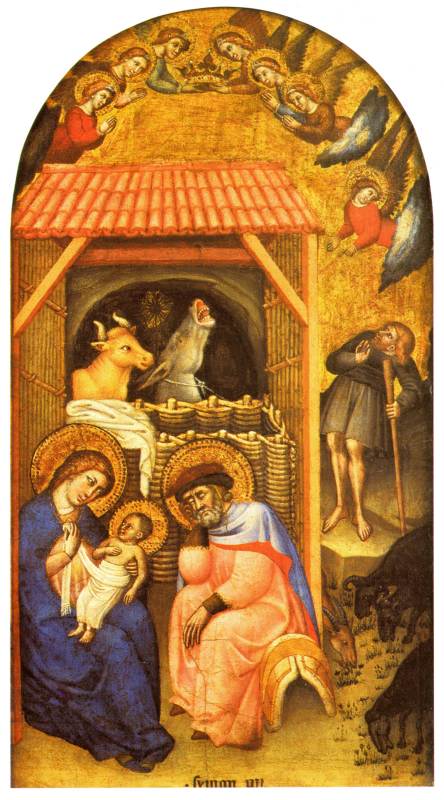 (at the bottom there is depicted a goat), which, most likely, is the ‘ancient’ Amalthea. Furthermore – king Herod seeking to kill Jesus. The Magi deception of Herod is the deception of Cronus by Rhea, who let him swallow a rock instead of Zeus [40], p.52. Massacre of the Innocents is Cronus gorging on his children. Interesting is the ‘ancient’ Greek myths claiming that Zeus was hidden from Cronus AMONG THE BEARS, see above. And that Zeus was protected by the armoured guards. This wonderfully matches the biography of Andronicus-Christ, who was hiding from Manuel-Herod in Russia, among the bears and the army loyal to him. (To remind you, that Russia was often called ‘a country of the bears’). Further, Zeus becomes Cronus’ cupbearer’. This corresponds with the temporary reconciliation between Andronicus and Manuel, described by Nicetas Choniates.
(at the bottom there is depicted a goat), which, most likely, is the ‘ancient’ Amalthea. Furthermore – king Herod seeking to kill Jesus. The Magi deception of Herod is the deception of Cronus by Rhea, who let him swallow a rock instead of Zeus [40], p.52. Massacre of the Innocents is Cronus gorging on his children. Interesting is the ‘ancient’ Greek myths claiming that Zeus was hidden from Cronus AMONG THE BEARS, see above. And that Zeus was protected by the armoured guards. This wonderfully matches the biography of Andronicus-Christ, who was hiding from Manuel-Herod in Russia, among the bears and the army loyal to him. (To remind you, that Russia was often called ‘a country of the bears’). Further, Zeus becomes Cronus’ cupbearer’. This corresponds with the temporary reconciliation between Andronicus and Manuel, described by Nicetas Choniates.
To conclude. In our opinion in the ‘most ancient’ Greek myths about Zeus there are reflected the fundamental features of Mediaeval Christian teaching. Consequently, these myths could not have appeared earlier than the XII century, the epoch of Christianity. Most likely they appeared much later, in the XV-XVI cc., when the Great = ‘Mongol’ Empire covered the vast territories of Eurasia, and Greece became the Imperial province. Those locals, who very rarely and with considerable difficulty reached the distant capital, told their countrymen of their impressions ‘on the Olympus and the Olympian gods and the holy Olympian history’. The stories branched out and gathered fantastical details like a snowball. Soon, in the XVII century The Empire fell apart and the myths, created not long prior to that, were declared to be folk tales of the very-very ‘ancient’ Greeks. It is for a reason that the Greek mythology became fashionable in Europe in the end of the XVII-XVIII cc. In the XIX century the peak of the interest towards it began to decline.